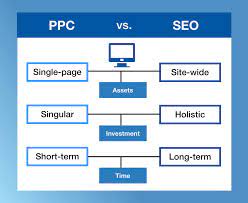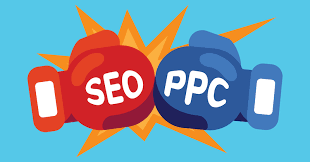Unlocking the Potential of Paid SEO: Elevating Your Online Visibility
The Power of Paid SEO: Boosting Your Online Visibility
Search Engine Optimization (SEO) is a crucial aspect of any digital marketing strategy. While organic SEO plays a significant role in improving your website’s visibility on search engines, paid SEO can take your online presence to the next level.
What is Paid SEO?
Paid SEO, also known as Search Engine Marketing (SEM) or Pay-Per-Click (PPC) advertising, involves paying for ads to appear on search engine results pages. These ads are typically displayed at the top of search results and are marked as ‘sponsored’ or ‘ad’ to differentiate them from organic listings.
The Benefits of Paid SEO
Immediate Results: Unlike organic SEO, which can take time to see significant results, paid SEO delivers immediate visibility for your website or products.
Precision Targeting: With paid SEO, you have control over who sees your ads based on factors such as location, demographics, interests, and more. This precision targeting ensures that your ads reach the right audience.
Increase Website Traffic: By appearing at the top of search results, paid SEO can drive more traffic to your website, resulting in increased brand awareness and potential conversions.
Best Practices for Paid SEO
To make the most of your paid SEO campaigns, consider the following best practices:
- Keyword Research: Identify relevant keywords that align with your business goals and target audience.
- Create Compelling Ad Copy: Craft engaging ad copy that entices users to click on your ads.
- Landing Page Optimization: Ensure that your landing pages are optimized for conversions to maximise the effectiveness of your paid campaigns.
- Monitor and Adjust: Regularly monitor the performance of your paid campaigns and make adjustments based on data insights to improve results over time.
In Conclusion
Paid SEO is a powerful tool for boosting your online visibility and driving targeted traffic to your website. By incorporating paid strategies into your overall digital marketing efforts, you can reach a wider audience and achieve tangible results in a shorter timeframe. Consider integrating paid SEO into your marketing mix to unlock its full potential and propel your online presence forward.
Top 8 Benefits of Paid SEO: Boosting Traffic, Visibility, and Credibility
- Immediate results
- Precise targeting
- Increased website traffic
- Enhanced brand visibility
- Measurable results
- Competitive advantage
- Flexibility
- Brand credibility
Challenges of Paid SEO: High Costs, Short-Lived Gains, Ad Blindness, and Fierce Competition
Immediate results
Paid SEO offers a significant advantage in providing immediate results by delivering instant visibility for your website or products. Unlike organic SEO efforts that may take time to gain traction, paid SEO allows businesses to quickly appear at the top of search engine results pages, ensuring that their offerings are prominently displayed to potential customers right from the start. This instant visibility can lead to increased website traffic, brand awareness, and potential conversions, making paid SEO a valuable tool for businesses looking to make an immediate impact in the digital landscape.
Precise targeting
One significant advantage of paid SEO is precise targeting, allowing you to tailor your ads to specific demographics, interests, and other criteria. By having control over who sees your ads, you can ensure that your messaging reaches the most relevant audience for your business. This targeted approach not only increases the effectiveness of your campaigns but also enhances the likelihood of engaging with potential customers who are more likely to convert, ultimately maximising the return on your investment in paid SEO strategies.
Increased website traffic
Paid SEO offers a significant advantage in increasing website traffic. By investing in paid search advertising, businesses can drive a higher volume of targeted traffic to their websites. This surge in traffic not only enhances brand visibility but also creates more opportunities for conversions. With paid SEO, companies can effectively reach their desired audience and attract potential customers who are actively searching for products or services they offer, ultimately leading to improved brand recognition and increased sales potential.
Enhanced brand visibility
Paid SEO offers the significant advantage of enhanced brand visibility. By having ads prominently displayed at the top of search results, businesses can increase their brand exposure to a broader audience. This increased visibility not only helps in capturing the attention of potential customers but also reinforces brand recognition and awareness. With paid SEO, companies can effectively reach out to a larger pool of online users, ultimately boosting their brand presence and standing out in the competitive digital landscape.
Measurable results
One significant advantage of paid SEO is its ability to provide measurable results. By utilising paid search engine marketing strategies, you can track key performance metrics such as click-through rates, conversion rates, and return on investment. This data-driven approach enables you to analyse the effectiveness of your campaigns in real-time and make informed adjustments to optimise for better outcomes. The ability to measure and adjust campaigns based on concrete data sets paid SEO apart as a valuable tool for enhancing online visibility and achieving tangible results.
Competitive advantage
In the realm of paid SEO, one significant advantage is the ability to gain a competitive edge by outbidding competitors for top ad placements. Securing prime positions in search engine results through paid advertising can elevate your visibility and attract more clicks from potential customers. By strategically outbidding competitors, you can effectively position your brand ahead of others in the market, increasing your chances of capturing valuable leads and driving conversions. This competitive advantage offered by paid SEO empowers businesses to stand out in a crowded digital landscape and assert their presence with authority.
Flexibility
One of the key advantages of paid SEO is its flexibility, allowing you to make quick and effective adjustments to your campaigns. With paid SEO, you have the freedom to tweak budgets, refine ad copy, and fine-tune targeting parameters effortlessly. This flexibility enables you to optimise your campaign performance in real-time, ensuring that your ads are reaching the right audience at the right time for maximum impact and results.
Brand credibility
Being prominently featured in search results through paid ads not only boosts your online visibility but also elevates your brand’s credibility. When users see your brand at the top of search engine results, it instils a sense of authority and trustworthiness. This increased visibility and recognition can significantly enhance your brand’s reputation and make it more appealing to potential customers, ultimately leading to greater trust and credibility in the eyes of your target audience.
Costly Investment
Paid SEO can be a costly investment, particularly when targeting competitive keywords and industries. Allocating a substantial budget for paid advertising campaigns is often necessary to outbid competitors and secure top ad placements on search engine results pages. For businesses operating in highly competitive markets, the expense of paid SEO can pose a financial challenge, making it crucial to carefully strategize and allocate resources effectively to achieve desired results while managing costs.
Temporary Results
While paid SEO can deliver immediate results and targeted traffic to your website, one significant drawback is its temporary nature. Unlike organic SEO strategies that can yield long-term benefits even after initial efforts, the advantages of paid campaigns come to a halt once you cease investing in them. This means that the visibility and traffic generated through paid ads are not sustainable in the long run, highlighting the importance of striking a balance between paid and organic SEO efforts for a comprehensive and enduring online presence.
Ad Blindness
In the realm of paid SEO, a notable drawback is the phenomenon of ad blindness. Users, becoming increasingly adept at recognising and disregarding paid advertisements, may overlook or consciously avoid clicking on these ads. This behaviour can result in lower click-through rates for paid campaigns, impacting the overall effectiveness of the strategy in reaching and engaging with the intended audience. Marketers need to navigate this challenge by crafting compelling ad copy and strategically placing ads to mitigate ad blindness and maximise the chances of capturing user attention and driving desired actions.
Competition Intensity
In fiercely competitive markets, the drawback of paid SEO becomes evident as businesses engage in bidding wars to secure top ad placements. This increased competition can drive up costs significantly, leading to diminishing returns on investment (ROI). The intensity of the competition in such environments can make it challenging for businesses to maintain a profitable presence through paid SEO strategies, as the cost of acquiring ad space may outweigh the benefits gained from increased visibility.

